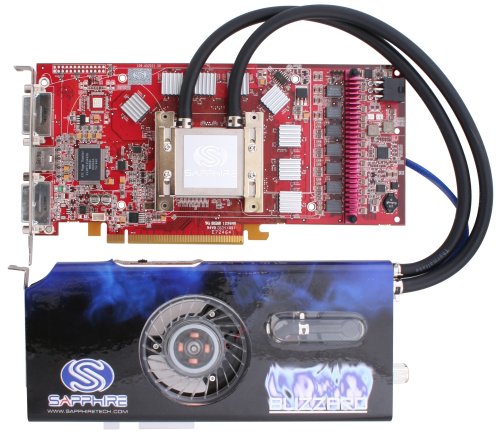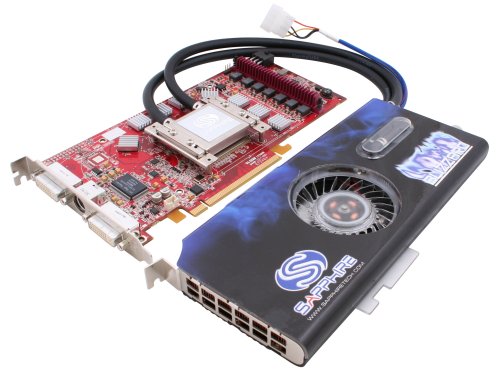Connect 3D and Sapphire Blizzard Radeon X1900 XTX
by Josh Venning on April 10, 2006 12:05 AM EST- Posted in
- GPUs
Blizzard Radeon X1900 XTX
The Blizzard Radeon X1900 XTX is a unique water cooled version of the X1900 XTX made by Sapphire. The design of this card is quite different than most that we've reviewed in that it is basically two separate units. It has a single-slot GPU, but there's a second water reservoir that takes a second slot and the two pieces are connected by two flexible hoses. The GPU is basically stripped of it's HSF, and the hoses run from the processor to the water block. The reservoir portion also circulates water via a quiet 12 volt "mini pump."
The Blizzard comes completely assembled and already filled with coolant, so it's fairly simple to install and get running. An extra 4-pin Molex power connection is required for the cooling solution in addition to the graphics card's standard 6-pin connection, and this will add to the power load on you PSU. Of course, if the GPU runs cooler it should draw less power, so we will have to wait for the empirical tests to find out which design actually requires less total power.

The Blizzard X1900 XTX comes with a factory overclock, which is something we've not seen with X1900 XTXs that we've tested in the past. The core clock comes set at 675 MHz as opposed to the standard 650MHz, and the memory clock is 800MHz versus the stock speed of 775MHz (1600 MHz effective vs. the default 1550 MHz). This overclock will give a slight boost in performance and makes for an attractive solution for those looking for something a little faster than the standard X1900 XTXs out there.

The Blizzard also comes with a familiar software bundle along with two Sapphire Select unlock keys. This allows you to choose two games from a selection of four: Tony Hawk's Underground 2, Prince of Persia: The Warrior Within, Brothers in Arms: Road to Hill 30, or Richard Burns Rally. None of the titles are really new, but all four are at least reasonable offerings. At least you have a reasonable chance of getting two new games this way, rather than getting a second copy of a game you already own.
The Blizzard Radeon X1900 XTX is a unique water cooled version of the X1900 XTX made by Sapphire. The design of this card is quite different than most that we've reviewed in that it is basically two separate units. It has a single-slot GPU, but there's a second water reservoir that takes a second slot and the two pieces are connected by two flexible hoses. The GPU is basically stripped of it's HSF, and the hoses run from the processor to the water block. The reservoir portion also circulates water via a quiet 12 volt "mini pump."
The Blizzard comes completely assembled and already filled with coolant, so it's fairly simple to install and get running. An extra 4-pin Molex power connection is required for the cooling solution in addition to the graphics card's standard 6-pin connection, and this will add to the power load on you PSU. Of course, if the GPU runs cooler it should draw less power, so we will have to wait for the empirical tests to find out which design actually requires less total power.

The Blizzard X1900 XTX comes with a factory overclock, which is something we've not seen with X1900 XTXs that we've tested in the past. The core clock comes set at 675 MHz as opposed to the standard 650MHz, and the memory clock is 800MHz versus the stock speed of 775MHz (1600 MHz effective vs. the default 1550 MHz). This overclock will give a slight boost in performance and makes for an attractive solution for those looking for something a little faster than the standard X1900 XTXs out there.

The Blizzard also comes with a familiar software bundle along with two Sapphire Select unlock keys. This allows you to choose two games from a selection of four: Tony Hawk's Underground 2, Prince of Persia: The Warrior Within, Brothers in Arms: Road to Hill 30, or Richard Burns Rally. None of the titles are really new, but all four are at least reasonable offerings. At least you have a reasonable chance of getting two new games this way, rather than getting a second copy of a game you already own.










24 Comments
View All Comments
gersson - Monday, April 10, 2006 - link
Thank you for constantly deleting my posts especially if they have something completely harmless and neutral. I notice that they are usually erased when I am the 1st poster...This is my last post @ daily tech. Enjoy it while it still exists -_-
JarredWalton - Monday, April 10, 2006 - link
Not sure if Daily Tech has deleted any of your posts or not, but I can tell you that there have been 13 comments on this article so far (this will the #14) and none of them have been deleted. None of them have been "voted down" either, so by default you should see all the comments. You might want to verify that your filter at DailyTech is set to -1 so that you can see all posts.LoneWolf15 - Monday, April 10, 2006 - link
I think it's likely that a solution from Arctic Cooling (i.e., the Accelero X) or one of Zalman's coolers would do as good of a job, be reasonably quiet, and not have the drawbacks that a liquid-cooled setup would. It would be interesting to make a comparison as to how they would stack up.The Sapphire card looked interesting, but the results indicated to me it's a lot of sizzle without much steak.
Questar - Monday, April 10, 2006 - link
"Of course, if the GPU runs cooler it should draw less power"This is new to me. Can you point me to anything to back this up?
NegativeEntropy - Monday, April 10, 2006 - link
As you imply, the author is either mistaken (as the evidence shows) or was making a faulty assumption. For a given CMOS chip to consume less power one of two things needs to happen: lower the frequency or the voltage. This assumes no fancy technology to turn off part of the chip. Assuming this thing runs at stock voltage, it should consume slightly more power than stock due to the frequency increase (not counting the pump).Gioron - Thursday, April 13, 2006 - link
Close to true, but not quite. The dynamic power of switching transistors is unnafected by temperature (its proportional to frequency and the supply voltage squared), but leakage current through an off transistor does decrease at lower temperatures and this current is a constant unaffected by the frequency. However, for most chips this isn't a huge difference... yet. As processes scale to smaller feature sizes leakage is increasing and some manufacturers have already run into problems with chips where 40% of their power is leakage and they suddenly had a chip using almost twice as much power as they expected, but most current chips see only a very small percent of their power usage as leakage current and making a small change to a small percentage of power is not likely to be noticable.DerekWilson - Thursday, April 13, 2006 - link
This comment resulted from a conversation I had with Josh about temperature and power. As you have mentioned here, leakage current does vary with temperature. And, in any material, conductivity is affected by temperature as well -- which will also affect power. Two otherwise identical chips will absolutely draw different ammounts of power if one is very cold and the other very hot. Whether this ammount is significant is not addressed in this article, but the fact does remain that temperature affects power draw.And, as has been pointed out, with 90nm and below we will see this phenomenon increase (provided no one stumbles upon a miraculous answer to the leakage problem).
Sunrise089 - Monday, April 10, 2006 - link
The Sapphire card seems pretty dissapointing. You give up an extra slot (right?) and pay ~$50 more to get almost no decrease in noise, almost no more of an overclock, and no less heat. Read that again: NO LESS HEAT! To me, a watercooling setup that runs equally hot as an air cooled setup isnt worth the leak risk, slight as it may be.JarredWalton - Monday, April 10, 2006 - link
Two things: it takes longer to get to the same temperatures. Second, standard XT/XTX cards are two-slot solutions, so this just makes the second slot movable to either side of the GPU. But yeah, it's a bit underwhelming. At least it's a bit quieter - X1900XTX cards aren't very good on noise levels.mkruer - Monday, April 10, 2006 - link
Does this seem completely pointless? Why not use heat pipes to draw more heat away from the core of the GPU and keep the fan heat sync in one assembly? This seems totally pointless unless you like having the possibility of your graphic card spring a leak.